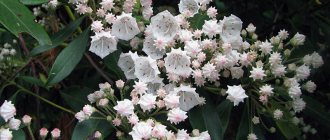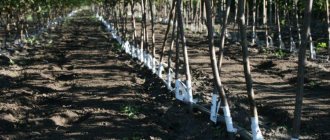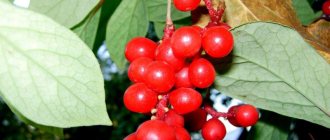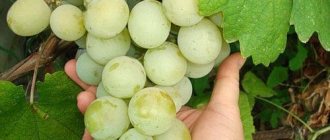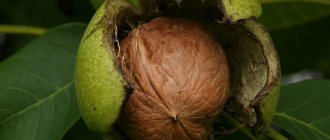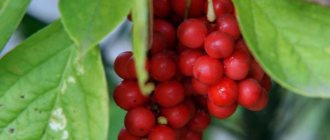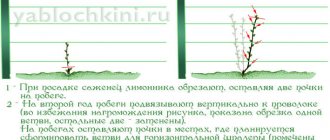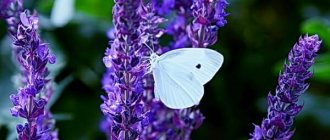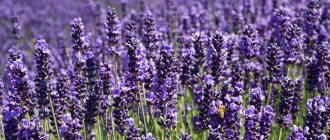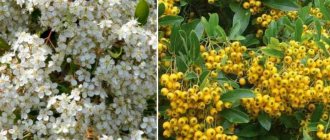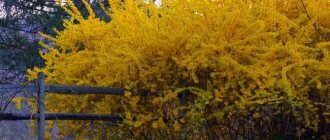What does the Schisandra chinensis plant look like and description?
Chinese lemongrass, or schisandra (Schisandra chinensis), is an ornamental perennial with liana-like shoots up to 15 m in length. The stems of the plant are thin, reddish when young and brown when mature. The leaves are elliptical, dark green on short petioles with well-defined veins. In autumn, the plant acquires an intense yellow color, and then quickly flies away almost completely.
Chinese lemongrass leaves emit a pleasant citrus aroma
How Chinese Schisandra blooms
The Chinese Schizandra schizandra enters its decorative period at the end of May or at the beginning of June. The plant's buds are small, male and female, on long stems. The petals are white or cream in color and turn pink at the end of flowering.
The discreet flowers of Chinese lemongrass reach about 2 cm in diameter
From mid-August, fruit clusters about 15 cm long appear in place of the female buds. They consist of 10-40 round red berries.
Appearance
First of all, it’s worth talking about the appearance. It is quite unusual: most of all the plant resembles a liana. Moreover, in warmer climates its length can reach ten or even fifteen meters! True, in the harsh Moscow region with relatively short summers and cold winters, the plant rarely exceeds four meters. The thickness of the stem is small (about two centimeters). The bark is wrinkled and dark brown. The vine wraps around almost any suitable object: from a tree growing nearby to a long cord or stake.
The leaves are large, about three to five wide, and up to ten centimeters long.
The flowers are not too large, about one and a half centimeters in diameter, and have a pronounced aroma. The color is predominantly white, but towards the end of flowering they turn pink. Collected in fairly large inflorescences.
After the flowering season ends, they turn into small berries that turn deep red as they ripen. They taste bitterish-burning with a pronounced taste of spice.
Varieties of Schisandra chinensis
Chinese lemongrass is represented on the horticultural market by several popular varieties. They differ among themselves in yield, degree of endurance and taste of the fruit.
Schisandra chinensis Firstborn
One of the newest Russian varieties of the plant is a medium-sized bush with vines of about 5 m. It bears small scarlet berries with bright red pulp in 12 cm clusters. The weight of one fruit bunch can be up to 12 g.
The Pervenets variety has good frost resistance and high immunity.
Schisandra Chinese Delight
Schisandra vines Delight reach 15 m in length, the variety is characterized by good yield - up to 5 kg of fruits from one bush. The berries are quite large, about 5 g in weight, with a pleasant sour-sweet taste. The plant begins to flower in May, and the variety bears fruit until October.
It is better to plant the Delight variety in the southern regions and the middle zone
Sadovyi-1
Chinese lemongrass is characterized by fast growth and good frost resistance. Suitable for growing in northern regions. Brings juicy sour berries up to 25 pieces in each cluster, the average yield is up to 6 kg per bush.
Sadovyi-1 can be planted in the garden without pollinators - the variety is self-fertile
Mountain
The Far Eastern variety of Chinese lemongrass bears fruit at the end of August. Produces dark scarlet, sour-bitter berries with dense, juicy pulp in clusters up to 9 cm long. The productivity of lemongrass is low, up to 2 kg per bush, but the plant is immune to diseases and is rarely affected by insects.
The Mountain variety is suitable for planting in the Urals and Siberia
Volgar
The cold-resistant variety rarely suffers from fungi and pests. Produces dioecious flowers, the harvest ripens in early September. The fruits of the plant emit a distinct resinous aroma and have a sour taste; each cluster contains up to 15 berries.
Volgar easily tolerates winter cold and summer drought
Oltis
Another Far Eastern variety has good yield - up to 4 kg per plant. The berries of Chinese lemongrass are small, dark scarlet in color, collected in clusters of 25-30 pieces. The plant demonstrates good resistance to fungal diseases and is valued for its weighty clusters weighing up to 27 g each.
The taste of the fruits of the Oltis variety is sour, with a bitter tinge.
Purple
One of the oldest Russian varieties bears fruit at the end of August and produces up to 4 kg per adult bush. The berries are small, bright scarlet, with thick skin, and sour in taste. The variety is very winter-hardy and suitable for growing in Siberia; its disadvantages include low immunity to fungal diseases.
For the first time, the Purple variety bears fruit already in the third year after planting
Planting and care
Landing Features
Faster growth and development occurs when planting a seedling. You can buy it at a specialty store or grow it yourself from seeds. Schisandra responds painfully to transplantation, so the planting material is immediately planted in its unchanged place of “habitat”.
Before planting, the top layer of soil is removed. A special substrate ( humus, sand, nitrogen, phosphorus ) is poured in its place. For a seedling, it is better to dig a hole with a depth and width of at least 50 cm. A drainage layer is required. It is created from fragments of brick, stone or rubble. The optimal distance between holes is 90-100 cm.
Seedlings are not planted at a great distance from each other. This has a detrimental effect on pollination. Efficiency can be achieved by planting seedlings in groups. This guarantees pollination and a rich harvest in the future.
Selecting a location
Preference should be given to an area with good lighting. The sun should be here at least 6 hours a day. Therefore, gardeners use the south side of the garden if they want to decorate the walls of a building or fence with lianas. Despite the openness of the area, it must be protected from gusts of wind and drafts. Icy, frosty winds will become dangerous for the bush. Also, when planting, the natural need of lemongrass for support is taken into account.
Soil preparation
Before planting, it is loosened and fed with humus, peat or ammonium nitrate. If the soil is acidic, then deoxidation is carried out. The optimal soil is neutral . Drainage is required. When planting, the ground should be sufficiently warm (at least 10 degrees). The period for it is selected when the danger of frost returning has passed.
Young vines need moisture most of all. Adult bushes are watered during prolonged drought. Spraying is preferred.
The need for fertilization with mineral complexes appears in a representative of the flora closer to 3 years of life. The most suitable fertilizers are phosphorus, nitrogen and potassium . They are applied in the form of mulch. It is combined with water and soil and mixed thoroughly.
Diseases and pests
The specific smell allows the Chinese schizandra not to know such troubles as bacteria and weeds. Even birds do not bother the vine. An exception is fungal diseases if the watering rules are violated. The bush is moistened by sprinkling in the evening or at night. The temperature should be above 23 degrees.
Held in the fall. Aimed at getting rid of old, dried stems and overgrown vines. Occasionally, the procedure is carried out in the summer, when the green growth is too dense.
In order to successfully withstand the cold season, the vine is watered and mulched abundantly. An adult garden planting is not afraid of temperature changes. But at extremely low temperatures, fruit buds may suffer. During such periods, the plant must be freed from its support, bent down to the soil and insulated with sawdust, dry leaves or spruce branches.
Peculiarities of cultivation in different regions of the country
Care for lemongrass depends on the growing region. The easiest way to grow a liana-like plant is in the south. In the northern regions, culture requires increased attention.
Growing and caring for Schisandra chinensis in Siberia
Most varieties are adapted to frosty winters and tolerate cold snaps down to -30 °C. But to prevent the Chinese lemongrass vines from freezing in Siberia, with the onset of autumn they must be removed from their support and laid on a bed of spruce branches or straw. The shoots are covered on top with a thick layer of fallen leaves or coniferous branches.
This allows you to insulate both the roots of the plant and the stems. The shelter must be removed once stable positive temperatures have been established.
Planting and caring for Chinese lemongrass in the Urals
In the Urals, Chinese lemongrass, and especially young plants, are also recommended to be removed from their support for the winter and covered with spruce branches from severe frosts. Mature vines can be left open if desired, but it is still necessary to cover the roots of the shrub with a layer of peat or fallen leaves.
In spring, the shelter must be removed when the snow begins to melt and after the first warmth has established. Otherwise, greenhouse conditions will develop under the mulch that are harmful to the roots.
Planting and caring for Schisandra chinensis in the Moscow region
The Moscow region is characterized by late return frosts, so it is better to plant perennials here not in May, but in June. With the onset of autumn, young plants need to be removed from the trellises and carefully covered with agrofibre, spruce branches or burlap. Adult specimens can be left on supports, but only if the winter is expected to be mild and snowy.
Growing Schisandra chinensis in the middle zone
Chinese lemongrass tolerates the climate of the middle zone quite well. You can plant the plant in the ground in the middle or end of May, depending on the weather. During the summer, you need to pay special attention to the frequency of watering. In the middle zone, long droughts often occur, and perennials develop and bear fruit less well in the absence of moisture for a long time.
In winter, a fence or other support can serve as a shelter for the lemongrass from the wind.
For the winter, young plants, as in most regions, are best laid on the ground and covered. Mature lemongrass can be left in place, especially if severe frosts are not expected.
Growing Schisandra chinensis in the Leningrad region
The plant tolerates the climate of northwestern Russia well; only young specimens need winter shelter. When growing a crop, it is necessary to ensure that the shrub receives enough light and develops on moderately moist and not swampy soil.
Important! A typical problem for the Leningrad region is unstable plant yield indicators. It is recommended to plant pollinators in the garden next to the crop.
Reproduction
The easiest way to propagate lemongrass is vegetatively - green cuttings, layering, shoots. The tops of young shoots are cut off for cuttings in early July. The bases of the cuttings are immersed in a heteroauxin solution for 12–24 hours. Then they are planted in a nursery with coarse river sand under a film.
Schisandra cuttings are obtained from strong annual vines formed from rhizome shoots.
In April, before the buds open, they are laid on loose soil, pinned down and sprinkled with soil mixed with humus or peat (a layer 10–15 cm thick). The top of the laid shoot is tied to the trellis. The roots of the cuttings appear in the 4th–5th month. Within 2–3 years, an independent, well-developed root system is formed. The cuttings are separated from the mother plant and planted in a permanent place. Rhizomatous schisandra shoots are separated from the mother plants in April - early May. To do this, dig out 2–4 branches of shoots growing nearby, but far enough from the adult plant. The offspring are immediately planted in a permanent place. Their roots cannot tolerate even short-term drying. For a month, the planted offspring are regularly watered and shaded from direct sunlight.
How to plant Schisandra chinensis correctly
Planting Chinese lemongrass is not particularly difficult. But you need to know the basic rules and clearly understand the algorithm.
Landing dates
Drop-off times vary by region. In the south of Russia, it is best to transfer the plant to the ground in September or early October, before the onset of winter it will have time to take root.
Planting Chinese lemongrass in spring is practiced in colder areas. At the same time, in the middle zone the perennial is rooted at the end of April or mid-May, but in Siberia, the Urals and even in the Moscow region they often wait until the first days of June. It is necessary for the soil to fully warm up and for recurrent frosts to pass.
Requirements for place and soil
Chinese lemongrass prefers well-lit areas. It can also develop in shaded places, but fruiting is greatly reduced. It is recommended to plant the plant under the cover of fences and buildings to protect it from strong winds and direct midday sun.
Soils suitable for perennials are loose, light and fertile, allowing air and moisture to pass through. Do not plant crops in close proximity to groundwater. The plant responds favorably to loams and sandstones, but does not develop well on clay and peat.
How to grow Chinese lemongrass from seeds
Seed propagation of perennials has an important feature; usually lemongrass is not grown in the house, but is sown directly into the ground. It is best to do this in the fall; in this case, the planting material is buried about 1.5 cm into the soil, and with the onset of winter it is properly covered with snow.
Chinese lemongrass grows slowly from seeds and adds only 5-7 cm per year
You can also save the seeds until spring. After collection, they are placed in a damp mixture of peat and sand and placed in the refrigerator for several months for stratification. With the onset of the warm season, after the soil has thawed, the planting material is transferred to the ground and then attention is paid to regular irrigation of the soil until the emergence of seedlings.
If you want to germinate the seeds of a crop at home, you need to save the fruits of the perennial until mid-winter. Only in January is the planting material removed from the berries, soaked in cool water for several days, and then kept at room temperature in moistened sand for about a month. Then, for the same period, the seeds need to be buried in the snow, and then planted in separate peat pots in a sand-peat mixture. The first shoots should appear in about two weeks; once warmer weather sets in, they can be moved into the garden and placed in the ground without removing them from the pots.
How to plant a Schisandra chinensis seedling
Most often, lemongrass is rooted with grown seedlings; this method is simpler and more convenient. A hole about 50 cm deep and 70 cm in diameter is dug in advance at the site. If planting is carried out in the spring, you need to prepare a place for the plant in the previous season, and if in the fall, then 2-3 weeks in advance.
A drainage layer of expanded clay, crushed stone or broken brick is laid at the bottom. Garden soil is mixed with humus, a little ash, potassium sulfate and superphosphate are added, and then the hole is half filled with the prepared substrate. The pit is covered with waterproof material and left until disembarkation.
Immediately after planting next to the Chinese lemongrass, it is advisable to install a support
Immediately before being transferred to the ground, a Chinese lemongrass seedling is soaked in water for a day, and then placed in the center of the planting hole, the roots are straightened and filled to completion. The neck of the plant must be left above the ground. The seedling is immediately watered with 20 liters of water, and then mulched in a circle with humus or peat chips. For quick rooting, it is necessary to tear off all the leaves from the plant and shorten the shoots to 3-4 growth buds, then all the nutrients will go to the development of the underground part.
Advice! In the first three weeks, it is recommended to cover the lemongrass with a light canopy from the rays of direct sun.
Planting material: how to choose a seedling
To grow lemongrass, which is used to create vertical gardening, it is necessary, first of all, to select a good and healthy seedling. It is best to choose a two- or three-year-old seedling. Despite the fact that the plant's vines may be short in length, the root system will already be developed and powerful. It is desirable that it have at least two main branches with a length of at least 25 cm.
Chinese lemongrass seedlings
When choosing, keep an eye on the roots - they should be undamaged and slightly moist, otherwise the survival rate and further growth of Chinese magnolia vine can be very slow. It’s good if the plants were recently dug up and sold with a lump of earth
Pay attention to the bark - it should be smooth and elastic, since wrinkled bark indicates that the tree was dug up quite a long time ago. If you purchase a seedling in the fall, then it is advisable to remove all the leaves so as not to damage the buds on the axils - this can also stop the growth of the plant
Be careful when transporting. Wrap the roots with a damp cloth and a plastic bag. If you nevertheless purchased a seedling with dry roots, immerse the plant in water for several days. What to do if it is not possible to plant Chinese lemongrass immediately after purchase? In this case, you need to bury it in a dark place on the site. Dig an elongated hole with a slight slope, carefully place the seedling in the hole and fill it on top so that not only the roots, but also half of the shoots themselves are under the soil. Don't forget to water the seedling.
Caring for Schisandra chinensis
When growing Chinese lemongrass, the main attention should be paid to watering. It is necessary to irrigate the ground under the plant by sprinkling twice a week in the absence of precipitation, and in bad weather - as the soil dries out. It is also useful to spray the leaves of the vines early in the morning or in the evenings.
The shoots require support, so the plant is usually placed close to walls or fences. If there are no structures nearby, it is necessary to install special trellises for the crop, which can be constructed from posts spaced at intervals of 3 m and wire stretched between them. In the summer, the developing stems are tied in a fan-shape so that each branch receives enough sunlight.
How to feed Chinese lemongrass
If complex fertilizers were applied when planting lemongrass, then it will need to be fed for the first time only in the third year. During the summer, the plant is watered with an infusion of bird droppings or manure once a month. After harvesting, it is necessary to feed the perennial with superphosphate and potassium or wood ash. Once every few years in early spring, 30 liters of rotted compost or humus can also be distributed at the roots of the plant.
When and how to prune Schisandra chinensis
The perennial grows rather slowly and requires pruning for the first time only in the third year. It is necessary to carry it out, as fewer flowers are formed in dense vines, and as a result, the yield decreases.
The procedure is carried out in early spring at the beginning of March. During the process, all dry and broken shoots, as well as excess branches, are removed. It is necessary to leave only 5-7 strong stems on each vine, the remaining shoots are shortened to the growth point. In the fall, pruning of Chinese lemongrass is carried out again for sanitary purposes, to eliminate diseased and weak branches.
Schisandra is cut along bare vines in order to cause less injury and to better see what needs to be trimmed.
Important! In order to rejuvenate an adult plant, shoots that have bear fruit over the past three years should be regularly cut off.
When and how to replant
Transplantation to a new place for Chinese lemongrass is carried out in the spring before the buds awaken, in March or early April. It is also permissible to perform the procedure in the fall after harvesting.
The plant is carefully removed from the support and the root part is dug out of the ground, and then immediately transferred to a previously prepared area. In the process, you can separate a part of the rhizome with several healthy vines and thus get two mature and strong specimens at once.
Diseases of Schisandra chinensis and how to treat them
Most varieties have good immunity and successfully resist fungi. The danger to culture is mainly:
- fusarium - against the background of the disease, the shoots of the plant darken and become thinner, and the leaves begin to turn yellow;
Young lemongrass suffers more often from fusarium
- powdery mildew - the fungus attacks the plant on waterlogged soils and leaves a whitish coating on the leaves and shoots;
Under the influence of powdery mildew, lemongrass begins to turn brown, wither and eventually die.
- ascochyta blight - brown spots with a dark border appear on the leaves of the plant; small black dots of fungal spores can be seen on the back of the leaves.
Ascochyta blight spots dry out over time and turn into holes
When disease symptoms occur, the affected vines are pruned and burned. The fight against fungi is carried out using Bordeaux mixture, fungicides Topaz, HOM and Skor and copper sulfate. Spray the plant several times a season with an interval of 2-3 weeks. A month before harvest, treatments are stopped so that the fruits do not accumulate chemicals.
Why doesn't Schisandra chinensis bear fruit?
There are several main reasons why an adult plant does not bear berries:
- incorrectly chosen sex of Schisandra - only perennials with “female” buds can bear fruit, and most of them need pollinators;
- lack of light - the crop cannot bloom profusely and form ovaries in dense shade;
- abundance of shoots - it is necessary to regularly trim off excess shoots and root layers so that the plant actively develops upward.
If a perennial does not bear fruit the first year, although it has already produced berries before, the likely cause is an unsuccessful spring. During the cold and rainy season, pollination may not take place.
Pests and methods of controlling them
Chinese lemongrass very rarely suffers from parasites. Among insects, the main danger to it is the spider mite. The insect appears in hot and dry weather.
A characteristic sign of mite infestation is cobwebs on the underside of the leaves.
You can fight spider mites with insecticidal preparations - spraying is carried out several times with an interval of 1-2 weeks. The best prevention of the appearance of the pest is regular watering and irrigation of lemongrass throughout the crown.
Schisandra chinensis in landscape design
The ornamental perennial with its pleasant citrus aroma is used not only as a fruit plant. Photos of Chinese lemongrass in the garden show that the culture is used:
- for decorating arches and gazebos;
Schisandra vines on an arch in the garden give it an airy and romantic look
- for decorating walls and fences;
Lemongrass allows you to decorate a wall and disguise defects on it
- for the formation of hedges;
Lemongrass can be used to decorate a fence or divide the interior space of a garden into zones.
With the help of Chinese lemongrass, you can give an attractive look to neglected areas on the site. For example, vines successfully cover communications and outbuildings that spoil the landscape.
Beneficial features
The fruits and seeds of Chinese magnolia vine are most often used for medicinal purposes. They contain large amounts of :
- vitamins;
- minerals;
- organic acids;
- essential oil.
In many countries, the plant is grown on an industrial scale and used in pharmacology. A few dried lemongrass berries can quickly restore strength and relieve fatigue. These fruits are also useful for those who experience excessive mental stress. At the same time, there are no side effects from eating berries.
Plant-based drugs are prescribed to normalize the functioning of the respiratory and cardiovascular systems. They are taken to activate the immune system and when exposed to adverse external factors. Medicines from lemongrass are often prescribed in combination with drugs whose action is aimed at curing depression and asthenic conditions.
Fresh fruit juice prevents the proliferation of pathogenic microorganisms. Powder from liana seeds normalizes the acidity of gastric juice and is often prescribed for the treatment of gastritis.
But, like any medicinal plant, lemongrass has its contraindications. Berries, juice and preparations based on lemongrass should not be taken by people prone to allergies and pregnant women. The plant can harm those who suffer from epilepsy, high blood pressure, insomnia, vegetative-vascular dystonia, increased nervous excitability and intracranial pressure, and arachnoiditis. Do not take lemongrass during acute infections.
